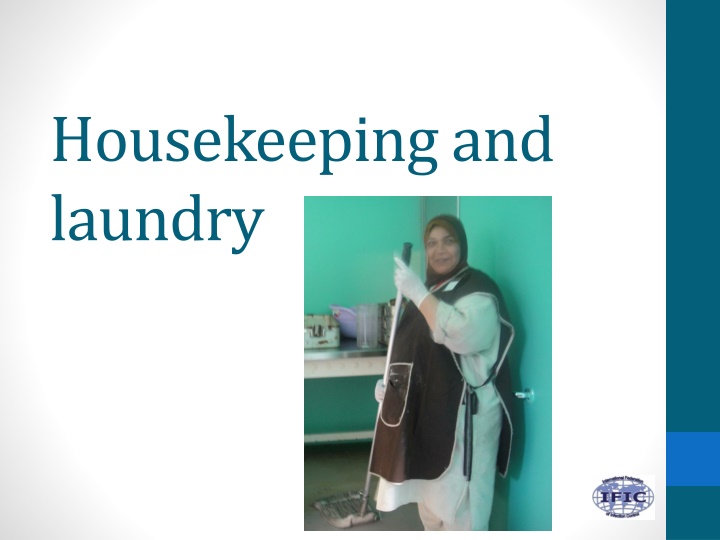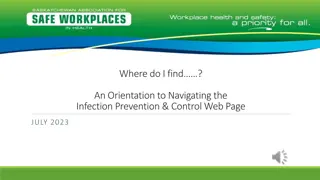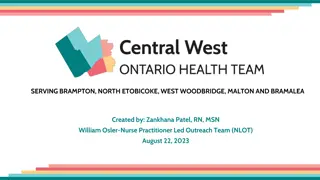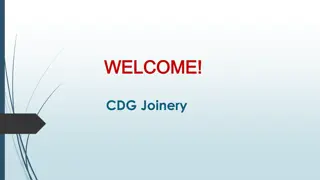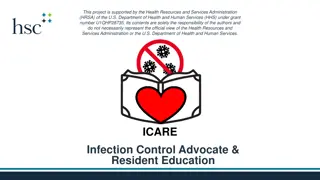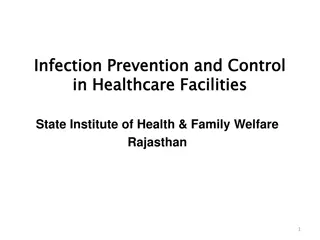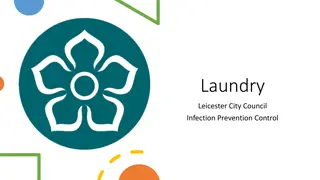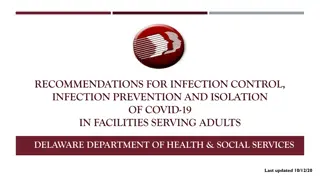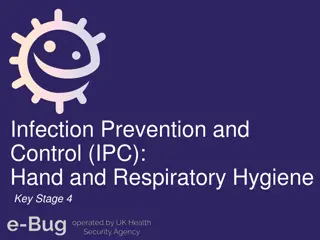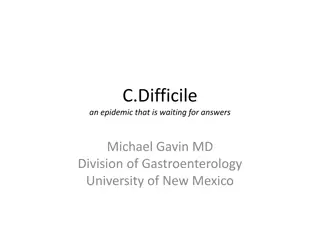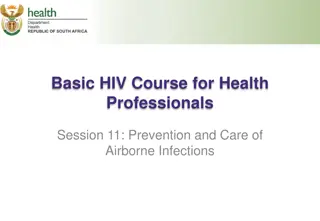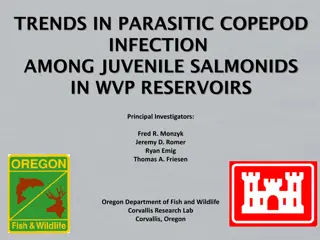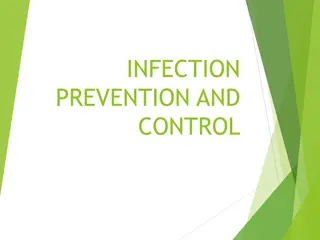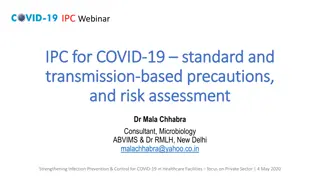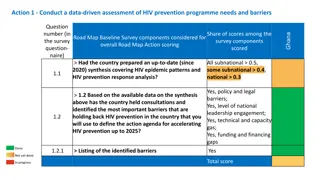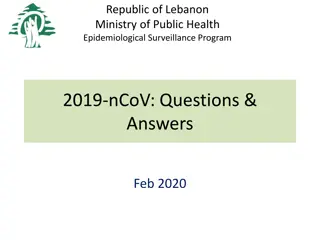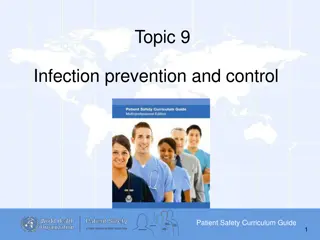Infection Prevention and Control in Housekeeping and Laundry Settings
This educational material covers the crucial role of infection prevention and control in environmental services, housekeeping, and laundry settings. Key topics include cleaning practices, sources of infection, the importance of the environment, and the use of disinfectants. It emphasizes the significance of proper training, supervision, and chemical handling to maintain a clean and safe healthcare facility.
Download Presentation

Please find below an Image/Link to download the presentation.
The content on the website is provided AS IS for your information and personal use only. It may not be sold, licensed, or shared on other websites without obtaining consent from the author.If you encounter any issues during the download, it is possible that the publisher has removed the file from their server.
You are allowed to download the files provided on this website for personal or commercial use, subject to the condition that they are used lawfully. All files are the property of their respective owners.
The content on the website is provided AS IS for your information and personal use only. It may not be sold, licensed, or shared on other websites without obtaining consent from the author.
E N D
Presentation Transcript
Housekeeping and laundry
Learning objectives December 1, 2013 1. Identify the role of infection prevention and control in environmental services, housekeeping, and laundry settings. 2. Outline the role of chemicals, training, and work practices in infection prevention. 3. Explain the importance of the environment in infection prevention and control. 2
Time involved December 1, 2013 35 minutes 3
Key Points Cleaning performed using water and detergent Neutral detergents adequate for most cleaning purposes Cleaning staff must be properly trained and supervised An ongoing cleaning schedule must be established All linen, whether visibly soiled or superficially clean, must be processed to the same high standard December 1, 2013 4
Sources of Infection December 1, 2013 The infected patient is the primary source of infection The inanimate environment is rarely the primary source of infection outbreaks Contaminated water and bedding may result in opportunistic infections 5
The Environment December 1, 2013 Around an infected patient, the close environment may be contaminated by Direct patient shedding droplet-contact or airborne-contact) Healthcare workers touching instruments, door knobs or other surfaces 6 indirect contact
Why Cleaning? Clean the environment around discharged patients to prevent build-up of material that may harbour potential pathogens A clean, well-maintained healthcare facility inspires confidence in patients, staff and the public Dirt breeds dirt ... December 1, 2013 7
Disinfectants December 1, 2013 Surface disinfectants Chemical in nature Hazardous and must be handled only by trained staff Pose a risk to the environment Use detergent/disinfectants that clean well and are not inactivated by organic matter 8
General Cleaning 1 December 1, 2013 Vigorous cleaning with water and neutral detergents reduces or eliminates reservoirs of potential pathogens Cleaners must be properly trained and supervised An ongoing cleaning schedule must be established 9
General Cleaning 2 December 1, 2013 Visible dust and dirt should be removed Duct, fan, and air conditioning systems should be cleaned on a routine basis Keep housekeeping surfaces visibly clean on a regular basis floors, walls, and tabletops Clean up spills promptly 10
Cleaning Schedule - 1 December 1, 2013 Who is responsible for specific jobs Work procedures, including special equipment and supplies cleaning and storage of equipment mop head changing Use of protective clothing Accountability 11
Cleaning Schedule -2 December 1, 2013 Frequency of floor cleaning solution and mop change furniture cleaning toilet, commode and fixture cleaning cleaning fixtures such as ice machines cleaning grilles and air-ducts 12
Cleaning items December 1, 2013 13
Cleaning Schedule -3 December 1, 2013 Walls do not need frequent cleaning Floors and tables collect dust and need cleaning with water and detergent Small surfaces frequently touched may need more frequent cleaning Good hand hygiene is important for nursing staff, cleaners, helpers, and patients! 14
Surface/object Procedure Horizontal surfaces 1. Thorough regular cleaning 2. Cleaning when soiled 3. Cleaning between patients/clients and after discharge December 1, 2013 Walls, blinds, curtains Should be cleaned regularly with a detergent and as splashes/visible soil occur. Floors 1. Thorough regular cleaning 2. Cleaning when soiled 3. Cleaning between patients/clients and after discharge. Damp mopping preferred Carpets/upholstery Should be vacuumed regularly and shampooed as necessary. Toilets and commodes 1. Thorough regular cleaning 2. Cleaning when soiled 3. Clean between patients/clients and after discharge. Use a low level disinfectant. 15 From Infection Control Guidelines - Hand Washing, Cleaning, Disinfection and Sterilization in Health Care CCDR Supplement Volume 24S8, December 1998
Laundry Services December 1, 2013 Sorting procedures Washing processes 16
Objectives To prevent the transmission of infectious disease between patients and staff To enhance patient comfort To process all linen to the same high standard To remove gross soil (e.g., faeces) by dumping it into a sluice, clinical sink, or down a toilet December 1, 2013 17
Sorting Procedures: In the Ward December 1, 2013 Avoid contaminating hands with soil Place soiled linen in a water-impermeable laundry bag Secure bag when full Leave bags in secure place for pick-up and transport Beware of the risk to laundry workers from sharp objects left in soiled linen! 18
Linen Transport December 1, 2013 Bags should be tied securely and not over-filled when transported either by chute or cart 19
Sorting Procedures: In the Laundry December 1, 2013 Sort laundry bags in area for dirty linen Educate laundry sorters Provide sorters with gloves and aprons/gowns Presort soiled linen into washer loads Minimise handling of soiled linen 20
In the Washing Machine December 1, 2013 Prewash rinse cycle 15 minutes Wash in cold water wash, add bleach (2 mL/ litre of water) with detergent or Wash at >71oC if detergents with bleach are not used Add souring agent during rinse cycle 21
HandlingafterWashing December 1, 2013 Dry linen soon after washing to prevent any regrowth of bacteria Hot air drying or drying on a clothesline in sunlight reduces numbers of bacteria Ironing will destroy pathogens especially using a steam iron 22
StorageandPackaging December 1, 2013 Store and transport clean linen so that contamination is avoided Wrap linen to be sterilised appropriately 23
Role of Infection Prevention & Control December 1, 2013 Help perform a risk assessment to identify high-touch surfaces Provide advice on cleaning strategy and schedules Evaluate products Especially any disinfectants 24
References December 1, 2013 Malik RE, et al. Use of audit tools to evaluate the efficacy of cleaning systems in hospitals. Am J Infect Control 2003; 31:181-7. Dettenkofer M, et al. Does disinfection of environmental surfaces influence nosocomial infection rates? Am J Infect Control 2004; 32(2):84-9. Spencer RC. Importance of environmental decontamination--a critical view. J Hosp Infect 2007; 65 (Suppl 2):55-7. 25
Quiz 1. A key role of infection prevention and control in housekeeping/laundry involves working with staff on safe practices. T/F? Potential housekeeping-related infection risks are a) Proximity of patients to each other b) An infected patient c) Air quality d) All of the above Cleaning influences the spread of infections by: a) Decreasing soil that might carry pathogens b) Dry dusting walls c) The type of carpet in patient rooms d) All of the above December 1, 2013 2. 3. 26
Quiz 4. Proper storage of clean linen includes a) Avoiding contamination b) Use of a single storage space c) Separation from soiled linen d) All of the above Handling linen properly influences the spread of infections by: a) Removing gross soil b) Use of bleach c) Washing at >71 C d) All of the above December 1, 2013 5. 27
International Federation of Infection Control IFIC s mission is to facilitate international networking in order to improve the prevention and control of healthcare associated infections worldwide. It is an umbrella organisation of societies and associations of healthcare professionals in infection control and related fields across the globe . The goal of IFIC is to minimise the risk of infection within healthcare settings through development of a network of infection control organisations for communication, consensus building, education and sharing expertise. For more information go to http://theific.org/ December 1, 2013 28
